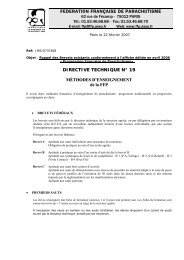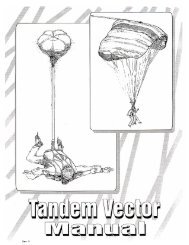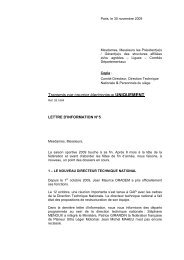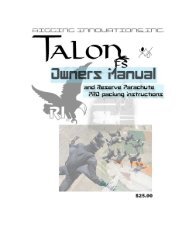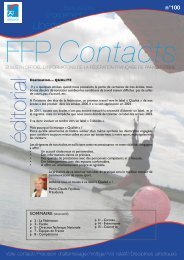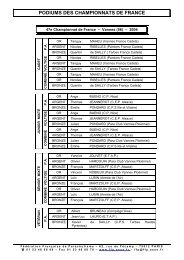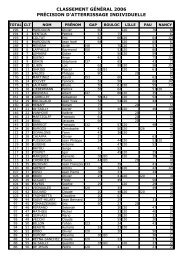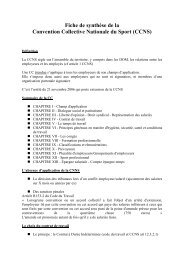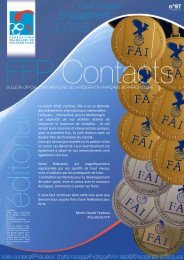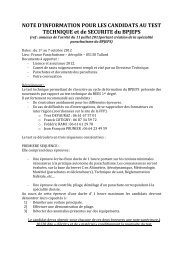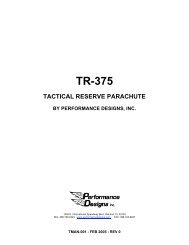Télécharger (PDF, 738KB) - Fédération Française de Parachutisme
Télécharger (PDF, 738KB) - Fédération Française de Parachutisme
Télécharger (PDF, 738KB) - Fédération Française de Parachutisme
Create successful ePaper yourself
Turn your PDF publications into a flip-book with our unique Google optimized e-Paper software.
Voilures ailes <strong>de</strong> secours<br />
Manuel d'entretien et <strong>de</strong> pliage<br />
Ram-air Reserve Canopy<br />
Owner's Manual<br />
Réf P/n P9009111400<br />
......................................<br />
voilure N°:<br />
Canopy N°:<br />
Edition N° 05 <strong>de</strong> Novembre 2000<br />
Conformément à la FEE N° 193<br />
Validée en date du 24/10/2000<br />
CERTIFICATION FRANCAISE<br />
FRENCH SPAE APPROVAL<br />
QUALIFICATION AVIATION CIVILE<br />
FRENCH AVIATION APPROVAL<br />
530 EQ 03<br />
QAC 121<br />
732 031 349 RCS Pontoise<br />
Lire, suivre, appliquer les avertissements , recomandations, et instructions <strong>de</strong> ce manuel<br />
QUALIFICATION CIVILE AMERICAINE<br />
US FAA APPROVAL<br />
Read and follow all WARNINGS, WARRANTY, INSTRUCTIONS for products of this manual.<br />
PARACHUTES DE FRANCE SA<br />
Manuel d’entretien et <strong>de</strong> pliage Techno - Edition 05 - Novembre 2000<br />
TSO C23d<br />
1/24
PARACHUTES DE FRANCE SA<br />
Voilure <strong>de</strong> secours<br />
Reserve canopy<br />
WARNING<br />
LE SPORT PARACHUTISTE EST UNE ACTIVITE À RISQUES DONT IL PEUT RÉSULTER DES BLESSURES OU LA MORT.<br />
LE DEVELOPPEMENT DES NOUVELLES DISCIPLINES DU SPORT PARACHUTISTE TELLES QUE LE FREE-FLY, LE FREE STYLE,<br />
LE SKY SURF ET LE KILOMETRE LANCE EN CHUTE CONDUIT FREQUEMMENT AU DEPASSEMENT DES LIMITES DE<br />
CERTIFICATIONS DES VITESSES DE DEPLOIEMENT DE VOTRE PARACHUTE.<br />
LES CONSEQUENCES DE TELS DEPLOIEMENTS A VITESSE SUPERIEURES AUX LIMITES DE CERTIFICATIONS PEUVENT<br />
ENTRAINER DE GRAVES BLESSURES OU LA MORT.<br />
1. UN ENTRAINEMENT ET/OU UNE EXPERIENCE DU PARACHUTISME SONT INDISPENSABLES POUR REDUIRE LES RISQUES<br />
DE BLESSURE GRAVE OU DE MORT. NE JAMAIS UTILISER CET EQUIPEMENT AVANT D'AVOIR:<br />
A. LU ET COMPRIS CET AVERTISSEMENT ET SUIVI UN PROGRAMME D'INSTRUCTION SPECIFIQUE À CE TYPE DE<br />
MATERIEL.<br />
-OU-<br />
B. LU ET COMPRIS CET AVERTISSEMENT, AINSI QUE TOUS LES MANUELS APPROPRIÉS, ET EFFECTUÉ AU MOINS 100<br />
SAUTS AVEC UN PARACHUTE DU TYPE ‘’AILE’’.<br />
2. POUR REDUIRE LES RISQUES D'OUVERTURE VIOLENTE, DE DOMMAGES, DE BLESSURE GRAVE OU DE MORT, NE PAS<br />
DEPASSER LES LIMITES INSCRITES SUR LE PANNEAU COUSU AU BORD DE FUITE DE LA VOILURE.<br />
3. A. LES PARACHUTES PEUVENT QUELQUEFOIS DISFONCTIONNER,MÊME S’ILS ONT ÉTÉ CONVENABLEMENT ÉTUDIÉS,<br />
CONSTRUITS, ASSEMBLÉS, PLIÉS, CERTIFIÉS, ENTRETENUS ET UTILISÉS. LES CONSÉQUENCES DE TELS<br />
DISFONCTIONNEMENTS PEUVENT ENTRAINER DE GRAVES BLESSURES OU LA MORT.<br />
B. SI VOUS UTILISEZ VOTRE PARACHUTE, OU SI VOUS AUTORISEZ UNE AUTRE PERSONNE À L’UTILISER, VOUS AVEZ<br />
CONNAISSANCE DES RISQUES DU PARACHUTISME ET VOUS ACCEPTEZ LE FAIT QUE CE PARACHUTE OU SES<br />
COMPOSANTS PUISSENT DISFONCTIONNER.<br />
C. SI VOUS N’ACCEPTEZ PAS LES RISQUES DU SPORT PARACHUTISTE, OU SI VOUS N’ACCEPTEZ PAS LA POSSIBILITÉ<br />
QUE VOTRE PARACHUTE OU SES COMPOSANTS PUISSENT DISFONCTIONNER ET VOUS CAUSER DES BLESSURES OU LA<br />
MORT, VOUS DEVEZ ALORS RECONSIDÉRER VOTRE IMPLICATION DANS LE SPORT PARACHUTISTE.<br />
SPORT PARACHUTING IS A HAZARDOUS ACTIVITY THAT CAN RESULT IN INJURY OR DEATH.<br />
THE EXPANSION OF NEW WAYS OF SPORT PARACHUTING AS FREE-FLY, FREE STYLE, SKY SURF AND SPEEDSKYDIVING<br />
OFTEN INVOLVE TO EXCEED THE CERTIFICATION DEPLOYMENT SPEED LIMITS OF YOUR PARACHUTE ASSEMBLY.<br />
RESULTS OF SUCH CERTIFICATION DEPLOYMENT SPEED LIMITS OVERSTEPPING MAY BE INJURY OR DEATH.<br />
1. TRAINING AND/OR EXPERIENCE ARE REQUIRED TO LOWER THE RISK OF SERIOUS INJURY OR DEATH. NEVER USE THIS<br />
EQUIPMENT UNLESS YOU HAVE:<br />
A. READ THIS WARNING LABEL AND COMPLETED A "CONTROLLED PROGRAM OF INSTRUCTION" IN THE USE OF THIS<br />
PARACHUTE ASSEMBLY.<br />
-OR-<br />
B. READ THE WARNING LABEL AND ALL APPROPRIATE OWNERS/FLIGHT MANUALS PACKING INSTRUCTIONS AND<br />
COMPLETED AT LEAST 100 RAM-AIR PARACHUTE JUMPS.<br />
2. LOWER THE RISK OF DEATH, SERIOUS INJURY, CANOPY DAMAGE AND HARD OPENING BY NEVER EXCEEDING THE<br />
LIMITS SHOWN ON THE LABEL LOCATED AT THE TRAILING EDGE.<br />
3. A. PARACHUTES SOMETIMES MALFUNCTION EVEN WHEN THEY ARE PROPERLY DESIGNED, BUILD, ASSEMBLED,<br />
PACKED, MAINTAINED AND USED. THE RESULT OF SUCH MALFUNCTIONS ARE SOMETIMES SERIOUS INJURY OR DEATH.<br />
B. IF YOU USE YOUR PARACHUTE- OR IF YOU ALLOW SOMEONE ELSE TO USE IT-YOU ARE ACKNOWLEDGING SPORT<br />
PARACHUTING’S RISK AND ACCEPTING THE FACT THAT THE PARACHUTE OR ITS COMPONENTS MAY MALFUNCTION.<br />
C. IF YOU ARE NOT WILLING TO ACCEPT THE RISKS OF SPORT PARACHUTING, OR IF YOU AREN’T WILLING TO ACCEPT<br />
THE POSSIBILITY THAT YOUR PARACHUTE OR ITS COMPONENTS MAY MALFUNCTION AND PERHAPS CAUSE YOU TO BE<br />
INJURED OR KILLED, THEN YOU SHOULD RECONSIDER YOUR INVOLVEMENT IN SPORT PARACHUTING.<br />
Lire, suivre, appliquer les avertissements , recomandations, et instructions <strong>de</strong> ce manuel Read and follow all WARNINGS, WARRANTY, INSTRUCTIONS for products of this manual.<br />
PARACHUTES DE FRANCE SA<br />
2/24<br />
Manuel d’entretien et <strong>de</strong> pliage Techno - Edition 05 - Novembre 2000
PARACHUTES DE FRANCE SA<br />
Voilure <strong>de</strong> secours<br />
Reserve canopy<br />
SOMMAIRE<br />
CONTENTS<br />
1 - PRESENTATION<br />
page<br />
1.1 - Avertissement<br />
1.1 - Introductory matter 4<br />
1.2 - Introduction 5<br />
1.3 - Description 6<br />
1.4 - Spécifications techniques et limitations 7<br />
1.4 - Technical specifications and limitations<br />
2 - INSTRUCTIONS D’UTILISATION<br />
OPERATING INSTRUCTIONS<br />
2.1 - Montage 8 - 9<br />
2.1 - Assembly<br />
2.2 - Pliage 10 - 19<br />
2.2 - Packing<br />
2.3 - Utilisation en vol 20<br />
2.3 - In flight use<br />
3 - INSPECTION & MAINTENANCE<br />
3.1 - Vérification avant emploi 21<br />
3.1 - Pre-flight use<br />
3.2 - Périodicité 21<br />
3.2 - Periodicity<br />
3.3 - Inspection 21<br />
3.3 - checking<br />
3.4 - Maintenance 22<br />
3.5 - Stockage 23<br />
3.5 - Storage<br />
Lire, suivre, appliquer les avertissements , recomandations, et instructions <strong>de</strong> ce manuel Read and follow all WARNINGS, WARRANTY, INSTRUCTIONS for products of this manual.<br />
PARACHUTES DE FRANCE SA<br />
3/24<br />
Manuel d’entretien et <strong>de</strong> pliage Techno - Edition 05 - Novembre 2000
PARACHUTES DE FRANCE SA<br />
Voilure <strong>de</strong> secours<br />
Reserve canopy<br />
1.1 - Avertissement:<br />
1 - Presentation<br />
1 - Presentation<br />
1.1 - Introductory matter:<br />
- Lisez et suivez toute instruction d'opération et toute spécification,<br />
instruction, conseils et exigences du fabricant pour l'utilisation du<br />
matériel.<br />
- Utilisez uniquement les composants d'origine PFSA.<br />
- Examinez tout équipement et/ou matériel, y compris toute installation,<br />
toute boucle, tout mousqueton ou tout autre système d'attache avant<br />
chaque utilisation <strong>de</strong> tout produit relatif au parachute.<br />
- Utilisez uniquement <strong>de</strong>s produits conçus pour l'usage défini par<br />
PARACHUTES <strong>de</strong> FRANCE SA.<br />
- N’ excé<strong>de</strong>z les forces, vitesses ou autres paramètres recommandés<br />
pour l'utilisation du matériel selon les règles <strong>de</strong> sécurité.<br />
- Lisez et respectez tout avertissement, manuel, instruction,<br />
recommandation, spécification d'entraînement ou d'expérience et toutes<br />
les procédures connues et enseignées concernant la pratique du<br />
parachutisme.<br />
- Ne tentez jamais d'utiliser un matériel sans être sûr qu'il a été<br />
conditionné, préparé, assemblé ou monté selon les règles <strong>de</strong> l'art par<br />
une personne qualifiée.<br />
- Apprenez à connaître votre matériel et examinez-le avant chaque<br />
utilisation.<br />
IL Y A DANGER DE BLESSURE GRAVE OU DE MORT A NE PAS<br />
SUIVRE TOUS LES AVERTISSEMENTS, INSTRUCTIONS ET<br />
PROCEDURES REQUIS.<br />
La plupart <strong>de</strong>s situations dangereuses dues au mauvais état d'un<br />
composant <strong>de</strong> parachute naissent d'une attitu<strong>de</strong> inconsciente si ce<br />
mauvais état est connu, négligente s'il est ignoré.<br />
Ne négligez donc pas les contrôles préliminaires qui vous sont<br />
conseillés à la section "maintenance " en fin <strong>de</strong> ce manuel.<br />
- Read and follow all operating instructions and all manufacturer<br />
specifications, instructions, advises and requirements for use of the<br />
equipment.<br />
- Use only genuine PFSA components.<br />
- Examine and replace ANY <strong>de</strong>fective, worn or <strong>de</strong>teriorated component.<br />
- Use only those products <strong>de</strong>signed for parachute use by<br />
PARACHUTES <strong>de</strong> FRANCE SA.<br />
- Do not exceed recommen<strong>de</strong>d or stated forces, speeds, or other factors<br />
regarding safe use of the equipment.<br />
- Read and follow all warning labels, manuals, instructions, training or<br />
experience requirements and recommendations and all recognised<br />
parachute use procedures.<br />
- Use equipment only when you are sure it was assembled, checked<br />
and packed by a qualified person.<br />
- Get a complete knowledge of your equipment and check it before each<br />
use.<br />
FAILURE TO FOLLOW ALL WARNINGS INSTRUCTIONS AND<br />
REQUIRED PROCEDURES MAY RESULT IN SERIOUS INJURY OR<br />
DEATH.<br />
Dangerous situations arising from a <strong>de</strong>fective parachute component are<br />
due to lack of attention when the <strong>de</strong>fect is not known and to sheer<br />
negligence when it is.<br />
The recommen<strong>de</strong>d preliminary checks should therefore not be<br />
neglected. Do not "skip" the first few pages of this manual, as all the<br />
information given is important. If in doubt, do not hesitate to consult a<br />
specialist.<br />
ATTENTION: Aussi soli<strong>de</strong> que soit votre expérience <strong>de</strong>s<br />
parachutes <strong>de</strong> type aile, nous vous engageons à lire le présent<br />
manuel avant d'aller plus loin.<br />
CAUTION: However vast your experience with ram-air canopies<br />
may be, please read this manual before jumping.<br />
Lire, suivre, appliquer les avertissements , recomandations, et instructions <strong>de</strong> ce manuel Read and follow all WARNINGS, WARRANTY, INSTRUCTIONS for products of this manual.<br />
PARACHUTES DE FRANCE SA<br />
4/24<br />
Manuel d’entretien et <strong>de</strong> pliage Techno - Edition 05 - Novembre 2000
PARACHUTES DE FRANCE SA<br />
1.2 - Introduction<br />
Voilure <strong>de</strong> secours<br />
1.2 - Introduction<br />
Reserve canopy<br />
Cher client,<br />
Nous souhaitons tout d'abord vous remercier pour l'achat d'une voilure<br />
PARACHUTES DE FRANCE.<br />
Nous vous recommandons vivement d'inspecter ou <strong>de</strong> faire inspecter<br />
soigneusement votre voilure afin <strong>de</strong> vous familiariser complètement<br />
avec ses caractéristiques et <strong>de</strong> constater la qualité <strong>de</strong> sa fabrication. Si<br />
quoi que ce soit ne vous paraissait pas normal, merci d'avertir<br />
immédiatement PARACHUTES DE FRANCE SA.<br />
Comment choisir votre voilure <strong>de</strong> secours?<br />
Les voilures <strong>de</strong> secours TECHNO PFSA sont déclinées en<br />
différentes tailles. La surface et le type <strong>de</strong> la voilure sont indiqués<br />
sur le panneau marque cousu au bord <strong>de</strong> fuite sur le caisson<br />
central.<br />
Le choix d'un modèle se fait en fonction du poids, <strong>de</strong> l'utilisation, et<br />
<strong>de</strong> la technicité <strong>de</strong> l'utilisateur.<br />
Choisir une voilure <strong>de</strong> secours est un acte personnel.<br />
Toutefois, l'usage <strong>de</strong> la voilure <strong>de</strong> secours pouvant parfois se faire<br />
dans <strong>de</strong>s conditions dificiles, nous vous recommandons <strong>de</strong> choisir<br />
une voilure confortable et pas trop petite.<br />
Les caractéristiques <strong>de</strong> vol d'une voilure sont la vitesse propre et la<br />
vitesse <strong>de</strong> <strong>de</strong>scente. Ces <strong>de</strong>ux éléments sont générés par le poids<br />
<strong>de</strong> l'utilisateur, qui est en quelque sorte le moteur.<br />
Plus le poids sera élevé, plus la vitesse sur trajectoire et la vitesse<br />
<strong>de</strong> <strong>de</strong>scente seront gran<strong>de</strong>s, plus la réponse aux comman<strong>de</strong>s sera<br />
vive et PLUS LE DÉCROCHAGE SERA VIOLENT ET SANS<br />
AVERTISSEMENT.<br />
A l'inverse, si le poids diminue, la vitesse propre et la vitesse <strong>de</strong><br />
<strong>de</strong>scente diminuent, la réponse aux comman<strong>de</strong>s sera plus douce et<br />
lente, le décrochage sera plus doux et prévisible.<br />
On comprend qu'un poids trop élevé produira <strong>de</strong>s vitesses propre et<br />
verticale trop gran<strong>de</strong>s, difficiles à maitriser. A ce moment vous<br />
prenez un grand risque, car il sera malaisé d'obtenir un atterrissage<br />
en sécurité, surtout si les conditions sont difficiles.<br />
Quelle est la bonne surface pour votre poids?<br />
La charge alaire est obtenue en divisant la masse totale équipée<br />
par la surface <strong>de</strong> la voilure.<br />
On entend par masse totale équipé le poids du parachutiste plus<br />
son habillement et ses accessoires plus l'équipement plié prêt à<br />
sauter.<br />
Exemple:<br />
- Parachutiste 70 kg<br />
- Habillement+ accessoires 5 kg<br />
- Parachute 10 kg<br />
- Total 85 kg<br />
Pour 17,70 m2 la charge alaire est: 85 / 17,70 = 4,8 kg/m2<br />
Si le nombre obtenu est <strong>de</strong> l’ordre <strong>de</strong> 4 kg/m2 (0,8 lb/sq.ft) la<br />
voilure est douce, facile à atterrir, et permet <strong>de</strong> se poser sur une<br />
zone réduite.<br />
Si le nombre est entre 4 et 4,8 (0,8 et 1.0 lb/sq.ft) la voilure est<br />
vive, elle a une bonne vitesse propre face au vent. Elle <strong>de</strong>man<strong>de</strong>ra<br />
une plus gran<strong>de</strong> expérience et sera plus délicate à l'atterrissage. La<br />
zone d'atterrissage doit être importante et bien dégagée à cause <strong>de</strong><br />
la vitesse propre élevée.<br />
Les voilures <strong>de</strong> secours ne sont pas faites pour être utilisées<br />
avec <strong>de</strong>s charges alaires dépassant 6,2 kg/m2 ou 1,27 lb/sq.ft.<br />
Masse maximum suspendue voir tableau page 7.<br />
Dear customer,<br />
First of all, we would like to thank you for purchasing a reserve canopy<br />
from PARACHUTES DE FRANCE.<br />
We strongly recommend that you carefully inspect your canopy, or<br />
have it inspected, so as to get used to its caracteristics and check<br />
quality of its workmanship. If anything would seem abnormal to you,<br />
please contact your local distributor or PARACHUTES DE FRANCE<br />
SA.<br />
How to choose your reserve canopy ?<br />
The PFSA reserve canopies come in several surface areas.<br />
Surface and mo<strong>de</strong>l are readable on the label stitched on the tail.<br />
The choice of a mo<strong>de</strong>l must be done regarding the weight, the use,<br />
and the individual jumper's skill.<br />
So, choosing a reserve canopy is a private <strong>de</strong>cision. However,<br />
because using a reserve ri<strong>de</strong> could occur in difficult conditions, we<br />
recommend to choose a comfortable and not to small canopy.<br />
Flight caracteristics of a canopy come from its proper forward speed<br />
and the vertical speed. Both speeds are generated by the user's<br />
weight, which can be regar<strong>de</strong>d as the engine.<br />
The higher the weight, the higher are speed on path and vertical<br />
speed, faster is the response to acting on toggles and quicker is<br />
reached the point of stalling.... WITHOUT ANY WARNING.<br />
On the contrary, if the weight goes down, basic speeds go down<br />
too.The answer to toggles is softer, the stalling point more<br />
predictable.<br />
So, it is un<strong>de</strong>rstandable that too much weight will generate too high<br />
speeds difficult to control. In this case you would take a big risk<br />
because it would be difficult to perform a safe landing, especially in<br />
<strong>de</strong>manding conditions.<br />
What is the right surface for your weight ?<br />
The wing load ratio is obtained by dividing the total weight of the<br />
jumper, plus his clothing and accessories, plus the weight of the rig<br />
ready to jump, by the surface of the canopy.<br />
Example:<br />
- Skydiver 155 lbs<br />
- Clothing+accessories 11 lbs<br />
- Rig 22 lbs<br />
- Max gross weight 188 lbs<br />
For 190 sq.ft the loading ratio is: 188 / 190 = 0,99 lb / sq.ft<br />
If the ratio you get is lower than 0,82 lb/sq.ft the canopy will be<br />
easy to land and will allow landing on small area.<br />
If the obtained ratio goes between 0,8 and 1,0 lbs/sq/.ft. the canopy<br />
will be swift and offering a good proper speed to face the wind. This<br />
given canopy will be sharp on landing and <strong>de</strong>manding a<br />
corresponding experience. Landing areas should be pretty large<br />
and cleared of obstacles. For your safety, do not forget this.<br />
Reserve canopies are not ma<strong>de</strong> to be used with wing loads<br />
greater than 6,2 kg/m2 or 1,27 lb.sqft.<br />
Maximum suspen<strong>de</strong>d weight refer to page 7.<br />
Lire, suivre, appliquer les avertissements , recomandations, et instructions <strong>de</strong> ce manuel Read and follow all WARNINGS, WARRANTY, INSTRUCTIONS for products of this manual.<br />
PARACHUTES DE FRANCE SA<br />
5/24<br />
Manuel d’entretien et <strong>de</strong> pliage Techno - Edition 05 - Novembre 2000
PARACHUTES DE FRANCE SA<br />
Voilure <strong>de</strong> secours<br />
Reserve canopy<br />
1.3 - Description<br />
Dépot <strong>de</strong> brevet N° 9408718<br />
Patent pending N° 9408719<br />
Extrados Top skin<br />
Nervures d'attache Rib.<br />
Intrados Bottom skin<br />
Nervures inter-caisson<br />
Divi<strong>de</strong>r ribs<br />
1<br />
Maillons rapi<strong>de</strong><br />
Connector links<br />
Extrados Top skin<br />
Saumon Lateral rib.<br />
A<br />
B<br />
C<br />
D<br />
E<br />
Stabilisateur stabilizer<br />
Butées <strong>de</strong> glisseur<br />
Sli<strong>de</strong>r stops<br />
Partie haute <strong>de</strong>s comman<strong>de</strong>s<br />
Upper steering lines<br />
Suspentes A<br />
Upper A lines<br />
Jonction en patte d'oie<br />
Casca<strong>de</strong>d junction<br />
Suspentes B<br />
Upper B lines<br />
Suspentes D<br />
Upper D lines<br />
Partie basse <strong>de</strong>s suspentes avant<br />
Front lower lines<br />
Partie basse <strong>de</strong>s suspentes<br />
arrière<br />
Rear lower lines<br />
2<br />
Suspentes C<br />
Upper C lines<br />
Partie basse <strong>de</strong>s comman<strong>de</strong>s<br />
Lower steering lines<br />
Point <strong>de</strong> freinage<br />
Brake set loop<br />
Glisseur Sli<strong>de</strong>r<br />
Lire, suivre, appliquer les avertissements , recomandations, et instructions <strong>de</strong> ce manuel Read and follow all WARNINGS, WARRANTY, INSTRUCTIONS for products of this manual.<br />
PARACHUTES DE FRANCE SA<br />
6/24<br />
Manuel d’entretien et <strong>de</strong> pliage Techno - Edition 05 - Novembre 2000
PARACHUTES DE FRANCE SA<br />
Voilure <strong>de</strong> secours<br />
Reserve canopy<br />
1.4 - Spécifications techniques et limitations:<br />
1.4 - Technical specifications and limitations:<br />
Système <strong>de</strong> mise en œuvre certifié: «POD libre»<br />
Certified <strong>de</strong>ployment system:<br />
«Free bag»<br />
Pliage certifié: Pliage décrit dans ce manuel<br />
Certified packing : Method instructed in this manual.<br />
Part number<br />
Type<br />
CARACTÉRISTIQUES TECHNIQUES- TECHNICAL DATA<br />
Modèle sq/ft 98 115 128 140 155 190 240<br />
R01-98-(X)<br />
224<br />
R01-115-(X)<br />
214<br />
R01-128-(X)<br />
215<br />
R01-140-(X)<br />
222<br />
R01-155-(X)<br />
216<br />
R01-190-(X)<br />
217<br />
R01-240-(X)<br />
218<br />
Surface extrados à plat m2-Planform area sq.ft (PIA) 9,6-104 10,7-115 11,9-128 13,13-141 14,4-155 17,7-190 22,3-240<br />
Surface moyenne m2-Average area sq.ft<br />
9,2-99<br />
10,2-110<br />
11,3-121<br />
12,51-134<br />
13,7-148<br />
16,5-178<br />
21,3-228<br />
Surface intrados m2-Lower skin area sq.ft<br />
8,7-94<br />
9,7-105<br />
10,7-115<br />
11,87-128<br />
13-141<br />
15,4-166<br />
20,1-217<br />
Envergure m-Span ft<br />
4,4-14,5<br />
4,8-16<br />
5,1-16,8<br />
5,15-16,9<br />
5,62-18,5<br />
6,23-20,4<br />
7,0-23<br />
Cor<strong>de</strong> m- Chord ft<br />
2,1-6,9<br />
2,2-7,3<br />
2,33-7,64<br />
2,45-8<br />
2,56-8,40<br />
2,84-9,32<br />
3,19-10,5<br />
Allongement-Aspect ratio<br />
2,2<br />
2,2<br />
2,2<br />
2,2<br />
2,2<br />
2,2<br />
2,2<br />
Caissons - Cells<br />
7 7 7 7<br />
7 7 7<br />
Poids kg-Weight lbs<br />
1,7-3,8<br />
1,9-4,2<br />
2,08-4,5<br />
2,26-4,98<br />
2,4-5,2<br />
2,7-5,9 3,2-7,32<br />
Volume - cubic inches<br />
270<br />
283<br />
302<br />
321<br />
334<br />
379<br />
469<br />
CERTIFICATION - LIMITATIONS<br />
Certification Française 530 EQ-03<br />
OUI<br />
YES<br />
OUI<br />
YES<br />
OUI<br />
YES<br />
OUI<br />
YES<br />
OUI<br />
YES<br />
OUI<br />
YES<br />
OUI<br />
YES<br />
QAC 121<br />
QAC 121<br />
JTSO C23d<br />
QAC 121<br />
JTSO C23d<br />
QAC 121<br />
TSO C23d<br />
QAC 121<br />
TSO C23d<br />
QAC 121<br />
TSO C23d<br />
Vitesse et masse maxi d’utilisation<br />
Speed and weight max<br />
66 kg<br />
145 lbs<br />
150<br />
kts<br />
66 kg<br />
145 lbs<br />
150<br />
kts<br />
74 kg<br />
163 lbs<br />
150<br />
kts<br />
90 kg<br />
198 lbs<br />
150<br />
kts<br />
100 kg<br />
220 lbs<br />
150<br />
kt<br />
113 kg<br />
249 lbs<br />
150<br />
kt<br />
130 kg<br />
286 lbs<br />
150<br />
kt<br />
Masse maximum recommandée kg - Max weight lbs<br />
56kg-124lbs<br />
58kg-128lbs<br />
65kg-143lbs 80kg-176lbs 90kg-198lbs 100kg-220 lbs 110kg-243lbs<br />
Vitesse verticale m/s (au niveau <strong>de</strong> la mer)<br />
Vertical speed ft/s (sea level ) ms-fps<br />
65 KG<br />
5,6 - 18,3<br />
77kg<br />
5,3 -17,4<br />
77kg<br />
5,1 -16,7<br />
77 kg<br />
4,8-15,7<br />
77kg<br />
4,4 -14,4<br />
77kg<br />
3,5 -11,5<br />
77kg<br />
3,0 - 9,8<br />
Test <strong>de</strong> résistance kg-Strenght test lbs<br />
Masse-Vitesse<br />
Weight-Speed<br />
120 kg-180kt<br />
265 lbs<br />
Masse-Vitesse<br />
Weight-Speed<br />
136 kg-180kt<br />
300 lbs<br />
Masse-Vitesse<br />
Weight-Speed<br />
136 kg-180kt<br />
300 lbs<br />
Masse-Vitesse<br />
Weight-Speed<br />
136 kg-180kt<br />
300 lbs<br />
Masse-Vitesse<br />
Weight-Speed<br />
136 kg-180kt<br />
300 lbs<br />
Masse-Vitesse<br />
Weight-Speed<br />
136 kg-180kt<br />
300 lbs<br />
Masse-Vitesse<br />
Weight-Speed<br />
157 kg-180kt<br />
346 lbs<br />
Calage différentiel <strong>de</strong>s suspentes Line trim<br />
Cm - Inches<br />
A-B<br />
7-2,7<br />
7-2,7<br />
8-3,1<br />
9 - 3,5<br />
9-3,5<br />
10- 3,9<br />
11-4,3<br />
A-C<br />
22- 8,6<br />
21-8,3<br />
25-9,8<br />
27-10,6<br />
27-10,6<br />
30-11,8<br />
34-13,4<br />
A-D<br />
42-16,5<br />
40-15,7<br />
47-18,5<br />
50 -19,6<br />
51-20<br />
57- 22,4<br />
67-25,2<br />
A-E position freiné-With brakes put on<br />
30- 11,8<br />
19-7,5<br />
21-8,3<br />
21-8,3<br />
17-6,7<br />
19-7,5<br />
24-9,5<br />
Lire, suivre, appliquer les avertissements , recomandations, et instructions <strong>de</strong> ce manuel Read and follow all WARNINGS, WARRANTY, INSTRUCTIONS for products of this manual.<br />
PARACHUTES DE FRANCE SA<br />
7/24<br />
Manuel d’entretien et <strong>de</strong> pliage Techno - Edition 05 - Novembre 2000
PARACHUTES DE FRANCE SA<br />
Voilure <strong>de</strong> secours<br />
Reserve canopy<br />
2.1 - Montage:<br />
2 - Instructions d’utilisation<br />
2.1 - Assembly:<br />
2 - Operating instructions<br />
Cette opération doit être effectuée par du personnel qualifié en fonction<br />
<strong>de</strong> la réglementation propre à chaque pays.<br />
Avant le montage <strong>de</strong> toute voilure <strong>de</strong> parachute celle-ci doit être<br />
inspectée et contrôlée. L’action <strong>de</strong> montage et <strong>de</strong> pliage implique que<br />
l’opérateur ait contrôlé que la voilure ainsi que le sac-harnais, ses<br />
composants et accessoires, soient en parfait état et bons <strong>de</strong> vol.<br />
Un gui<strong>de</strong> pour cette opération d’inspection et <strong>de</strong> contrôle figure au<br />
chapitre 3.3 - Inspection.<br />
Liaison aux élévateurs:<br />
Il est déconseillé, pour une voilure <strong>de</strong> secours d'utiliser <strong>de</strong>s manchons<br />
en élastomère, sans les fixer par couture aux maillons rapi<strong>de</strong>. Ne pas<br />
oublier <strong>de</strong> bloquer les écrous à la clef.<br />
Monter les poignées <strong>de</strong> manœuvre (Ici Atom) <strong>de</strong> la voilure comme<br />
expliqué. Pour toute information relative au freinage <strong>de</strong> la voilure se<br />
reporter au manuel du sac-harnais.<br />
This operation must be done by qualified persons in accordance with<br />
specific rules of each country.<br />
Before installation, the canopy must be inspected and checked.<br />
Installation and packing implies that the canopy, its components and<br />
accessories are in perfect condition and airworthy.<br />
A gui<strong>de</strong> <strong>de</strong>dicated to this operation of checking and control may be<br />
consulted in chapter 3.3 - inspection.<br />
Attachment to risers:<br />
For a reserve canopy it is not recommen<strong>de</strong>d to use elastomer sleeves<br />
without stitching them to the rapid links.<br />
Do not forget to tighten the nuts with a wrench.<br />
Install the toggles as shown (Atom in ex). For information on setting the<br />
brakes, refer to the harness container manual.<br />
1 2<br />
3 4<br />
Lire, suivre, appliquer les avertissements , recomandations, et instructions <strong>de</strong> ce manuel Read and follow all WARNINGS, WARRANTY, INSTRUCTIONS for products of this manual.<br />
PARACHUTES DE FRANCE SA<br />
8/24<br />
Manuel d’entretien et <strong>de</strong> pliage Techno - Edition 05 - Novembre 2000
PARACHUTES DE FRANCE SA<br />
Voilure <strong>de</strong> secours<br />
Reserve canopy<br />
Montage <strong>de</strong>s suspentes avant<br />
Connecting front lines to front risers<br />
Montage <strong>de</strong>s suspentes arrière<br />
Connecting rear lines to rear risers<br />
Montage <strong>de</strong>s comman<strong>de</strong>s<br />
Connecting steering lines to rear risers<br />
Contrôle du glisseur<br />
Check sli<strong>de</strong>r<br />
Contrôle du montage:<br />
Un contrôle complet du montage <strong>de</strong> la voilure doit être effectué. Il<br />
peut être réalisé au sol selon un ordre établi par le plieur, ou en<br />
gonflant la voilure pendant un temps suffisant à la vérification <strong>de</strong><br />
l'ensemble <strong>de</strong>s éléments.<br />
Check of installation:<br />
A complete check of canopy installation must be performed. It may<br />
be done on the ground following an or<strong>de</strong>r fixed by the rigger or/and<br />
by inflating the canopy during a sufficient time to check all<br />
elements.<br />
Lire, suivre, appliquer les avertissements , recomandations, et instructions <strong>de</strong> ce manuel Read and follow all WARNINGS, WARRANTY, INSTRUCTIONS for products of this manual.<br />
PARACHUTES DE FRANCE SA<br />
9/24<br />
Manuel d’entretien et <strong>de</strong> pliage Techno - Edition 05 - Novembre 2000
PARACHUTES DE FRANCE SA<br />
2.2 - Pliage:<br />
Voilure <strong>de</strong> secours<br />
2.2 - Packing:<br />
Reserve canopy<br />
Préalablement, il convient <strong>de</strong> s'assurer que la voilure et le sacharnais<br />
sont en parfait état <strong>de</strong> vol, la voilure correctement montée<br />
sur les élévateurs du sac-harnais et démêlée (voir §2.1: montage et<br />
§3.3: inspection).<br />
Notes: lorsque <strong>de</strong>s instructions sont données à propos <strong>de</strong> parties droite<br />
ou gauche <strong>de</strong> la voile, cela doit être interprété avec le plieur placé face<br />
à la voile et le sac-harnais situé dans son dos.<br />
Fixez le sac-harnais au sol, placez vous entre les élévateurs<br />
gauche et droite et remontez vers la voilure en tendant les<br />
suspentes.<br />
Placez les groupes <strong>de</strong> suspentes droite et gauche séparément sur<br />
les épaules, le glisseur <strong>de</strong>rrière la tête (Fig 1).<br />
Les suspentes doivent restées tendues pendant toutes la<br />
durée du pliage.<br />
Before starting to pack, inspect the complete assembly for<br />
airworthiness. Check if the canopy is correctly attached to the<br />
harness without any entanglements (see §2.1: assembly and §3.3:<br />
inspection).<br />
Notes: where instructions are given as left or right, this is to be<br />
interpreted as viewed facing down the packing area from the harness<br />
area to the canopy.<br />
Set the harness on ground, grasp lines between right and left risers<br />
facing canopy. Walk to canopy pushing the sli<strong>de</strong>r up to the bottom skin.<br />
Set the right and left lines groups on shoul<strong>de</strong>rs separately, sli<strong>de</strong>r behind<br />
neck (Fig 1).<br />
Throughout the following packing stages ensure the lines are kept<br />
taut at all the times.<br />
Fig 1<br />
Notes:<br />
Le pliage <strong>de</strong>s voilures <strong>de</strong> secours Techno s’effectue <strong>de</strong>bout dans un<br />
premier temps afin <strong>de</strong> marquer les plis qui préparent le pliage au<br />
sol, dans un <strong>de</strong>uxième temps.<br />
Le pliage étant symétrique, effectuez chaque phase <strong>de</strong> pliage pour<br />
une moitié <strong>de</strong> voile (gauche ou droite) puis pour l’autre.<br />
Notes:<br />
The packing of Techno reserve canopies is a stand up preparation<br />
to fold canopy fabric in a first time for a ground packing in a second<br />
time.<br />
As packing is symmetrical, execute each packing stage on a half<br />
canopy (right or left) in a first time and then the other half.<br />
Répartissez le tissu <strong>de</strong> voilure entre les groupes <strong>de</strong> suspentes comme<br />
indiqué ci-après (une moitié <strong>de</strong> voile aprés l’autre).<br />
La dénomination <strong>de</strong>s groupes <strong>de</strong> suspentes est définie au<br />
paragraphe1.3, page 6 (<strong>de</strong>scription).<br />
Fold the canopy fabric between lines groups as follows (with a half<br />
canopy in a first time and then the other half).<br />
The <strong>de</strong>signation of rigging lines groups is <strong>de</strong>finite in paragraph 1.3,<br />
page 6 (<strong>de</strong>scription).<br />
Lire, suivre, appliquer les avertissements , recomandations, et instructions <strong>de</strong> ce manuel Read and follow all WARNINGS, WARRANTY, INSTRUCTIONS for products of this manual.<br />
PARACHUTES DE FRANCE SA<br />
10/24<br />
Manuel d’entretien et <strong>de</strong> pliage Techno - Edition 05 - Novembre 2000
PARACHUTES DE FRANCE SA<br />
A - Preparation du pliage:<br />
Voilure <strong>de</strong> secours<br />
A - Packing preparation:<br />
Reserve canopy<br />
Ten<strong>de</strong>z et dégagez vers l’extérieur les trois entrées d’air <strong>de</strong>s caissons<br />
au bord d’attaque d’une moitié <strong>de</strong> voile, en laissant l’entrée d’air du<br />
caisson central face à vous (Fig 2).<br />
Pliez le tissu entre les groupes <strong>de</strong> suspentes A et B vers l’extérieur en<br />
vous aidant du bras (Fig 3).<br />
Tighten and clear the three nose inlet of a half canopy toward outboard,<br />
keeping the central cell inlet in front of you (Fig 2).<br />
Fold the fabric between A and B lines group to the outboard, using the<br />
arm (Fig 3).<br />
A<br />
B<br />
Fig 2<br />
Pliez le tissu entre les groupes <strong>de</strong> suspentes B et C vers l’extérieur en<br />
vous aidant du bras (Fig 4)<br />
Rassemblez le groupe <strong>de</strong> suspentes D dans une main et tirez-le vers<br />
l’extérieur (Fig 5), puis alignez le groupe <strong>de</strong> suspentes D sur les<br />
groupes A, B et C (Fig 6).<br />
Fig 3<br />
Fold the fabric between B and C lines groups to the outboard, using the<br />
arm (Fig 6).<br />
Grasp the D lines group and pull to the outboard (Fig 5), then level the<br />
D lines group with the A, B and C lines groups (Fig 6).<br />
A<br />
A<br />
B<br />
B<br />
C<br />
D<br />
C<br />
Fig 4<br />
Fig 5<br />
Lire, suivre, appliquer les avertissements , recomandations, et instructions <strong>de</strong> ce manuel Read and follow all WARNINGS, WARRANTY, INSTRUCTIONS for products of this manual.<br />
PARACHUTES DE FRANCE SA<br />
11/24<br />
Manuel d’entretien et <strong>de</strong> pliage Techno - Edition 05 - Novembre 2000
PARACHUTES DE FRANCE SA<br />
Voilure <strong>de</strong> secours<br />
Reserve canopy<br />
Alignez les comman<strong>de</strong>s (groupe E) avec les autres groupes <strong>de</strong><br />
suspentes en laissant le tissu du bord <strong>de</strong> fuite vers l’extérieur (Fig 6).<br />
Dégagez le stabilisateur vers l’extérieur (Fig7).<br />
Level the steering lines (E lines group) with the other lines groups,<br />
ensuring that the trailing edge fabric is placed to the outboard (Fig 6).<br />
Clear stabilizers toward outboard (Fig 7).<br />
A<br />
B<br />
C<br />
E<br />
D<br />
Fig 6 Fig 7<br />
Pliez l’autre moitié <strong>de</strong> voilure à l’i<strong>de</strong>ntique (Fig 8).<br />
Regroupez toutes les suspentes tendues dans une main et passez le<br />
bras sous le bord d’attaque pour poser la voilure au sol, suspentes<br />
tendues (Fig 9).<br />
Fold the other half of canopy as the first one (Fig 8).<br />
Group all rigging lines taut in one hand and lay canopy on the ground<br />
using the other arm placed un<strong>de</strong>r the nose and ensuring lines are kept<br />
taut. (Fig 9).<br />
Fig 8 Fig 9<br />
Lire, suivre, appliquer les avertissements , recomandations, et instructions <strong>de</strong> ce manuel Read and follow all WARNINGS, WARRANTY, INSTRUCTIONS for products of this manual.<br />
PARACHUTES DE FRANCE SA<br />
12/24<br />
Manuel d’entretien et <strong>de</strong> pliage Techno - Edition 05 - Novembre 2000
PARACHUTES DE FRANCE SA<br />
Voilure <strong>de</strong> secours<br />
Reserve canopy<br />
B - pliage au sol:<br />
B - Ground packing:<br />
Etalez la voile préparée sur le sol, suspentes tendues, en laissant le<br />
glisseur à distance <strong>de</strong> la voile (Fig 10).<br />
Débutez le pliage au sol en repliant une moitié <strong>de</strong> voile vers l’intérieur<br />
en respectant les plis précé<strong>de</strong>mment préparés.<br />
Laissez à plat sur le sol les trois entrées d’air du bord d’attaque (Fig 11).<br />
Lay the canopy on the ground with lines taut, keeping the sli<strong>de</strong>r away<br />
from canopy (Fig 10).<br />
Start ground packing by back folding a half canopy inboard, ensuring<br />
that the folds of packing preparation are respected.<br />
Keep the three nose inlets flat on the floor.(Fig 11).<br />
Fig 10 Fig 11<br />
Repliez à plat vers l’extérieur et lissez pour chasser l’air du tissu entre<br />
les groupes <strong>de</strong> suspentes A et B, aligner les groupes A et B (Fig 12).<br />
Back fold outboard the fabric between lines groups A and B and remove<br />
air from fabric, level B lines group with A lines group (Fig 12).<br />
Repliez par moitié le pli ainsi formé sous lui-même (Fig 13).<br />
Make a half roll with this new fold un<strong>de</strong>r itself (Fig 13).<br />
Fig 12 Fig 13<br />
Lire, suivre, appliquer les avertissements , recomandations, et instructions <strong>de</strong> ce manuel Read and follow all WARNINGS, WARRANTY, INSTRUCTIONS for products of this manual.<br />
PARACHUTES DE FRANCE SA<br />
13/24<br />
Manuel d’entretien et <strong>de</strong> pliage Techno - Edition 05 - Novembre 2000
PARACHUTES DE FRANCE SA<br />
Voilure <strong>de</strong> secours<br />
Reserve canopy<br />
Repliez à plat vers l’extérieur et lissez pour chasser l’air du tissu entre<br />
les groupes <strong>de</strong> suspentes B et C, alignez le groupe C sur A et B<br />
(Fig 14).<br />
Repliez par moitié le pli ainsi formé sous lui-même (Fig 15).<br />
Back fold outboard the fabric between lines groups A and B and remove<br />
air from fabric, level C lines group with A and B lines groups (Fig 14).<br />
Make a half roll whith this new fold un<strong>de</strong>r itself (Fig 15).<br />
Fig 14 Fig 15<br />
Rassemblez le groupe <strong>de</strong> suspentes D dans une main et tirez-le vers<br />
l’extérieur en maintenant le tissu dans l’axe <strong>de</strong>s groupes A, B et C<br />
(Fig 16).<br />
Repliez par moitié le tissu en alignant le groupe <strong>de</strong> suspentes D sur les<br />
groupes A, B et C (Fig 17).<br />
Dégagez le caisson central et donnez du mou aux comman<strong>de</strong>s <strong>de</strong><br />
manoeuvre pour freiner la voilure (Fig 17).<br />
Grasp the D lines group in one hand and pull toward outboard while<br />
holding fabric in axis of A, B and C lines groups (Fig 16).<br />
Then back fold fabric between C and D groups to level D lines group<br />
with A, B, and C lines groups (Fig 17).<br />
Clear the central cell and slacken the steering lines to set the<br />
<strong>de</strong>ployment brakes (Fig 17).<br />
Fig 16 Fig 17<br />
Lire, suivre, appliquer les avertissements , recomandations, et instructions <strong>de</strong> ce manuel Read and follow all WARNINGS, WARRANTY, INSTRUCTIONS for products of this manual.<br />
PARACHUTES DE FRANCE SA<br />
14/24<br />
Manuel d’entretien et <strong>de</strong> pliage Techno - Edition 05 - Novembre 2000
PARACHUTES DE FRANCE SA<br />
Voilure <strong>de</strong> secours<br />
Reserve canopy<br />
NOTES:<br />
Pour l’installation du freinage <strong>de</strong> la voilure<br />
reportez vous au manuel du sac-harnais.<br />
NOTES:<br />
To set the <strong>de</strong>ployment brakes of canopy refer<br />
to the harness manual.<br />
Dégagez le stabilisateur vers l’extérieur et alignez le premier brin <strong>de</strong>s<br />
comman<strong>de</strong>s dans l’axe <strong>de</strong>s autres groupes (Fig 18).<br />
Pliez le bord <strong>de</strong> fuite vers l’extérieur <strong>de</strong>mi-caissons par <strong>de</strong>mi caissons.<br />
Laissez le bord <strong>de</strong> fuite du caisson central ouvert (Fig 19).<br />
Clear the stabilizer toward outboard and level the first upper steering<br />
lines with the other lines groups (Fig 18).<br />
Back fold the trailing edge toward outboard half-cells after half-cells.<br />
keep the center cell trailing edge open (Fig 19).<br />
Fig 18 Fig 19<br />
Appliquez toutes les étapes précé<strong>de</strong>ntes du pliage au sol, à l’autre<br />
moitié <strong>de</strong> voile (Fig 20).<br />
Execute all the stages of ground packing for the other half canopy<br />
(Fig 20).<br />
Remontez le glisseur vers la voile comme indiqué (Fig 21).<br />
Pull the sli<strong>de</strong>r up to the canopy as shown (Fig 21).<br />
Fig 20 Fig 21<br />
Lire, suivre, appliquer les avertissements , recomandations, et instructions <strong>de</strong> ce manuel Read and follow all WARNINGS, WARRANTY, INSTRUCTIONS for products of this manual.<br />
PARACHUTES DE FRANCE SA<br />
15/24<br />
Manuel d’entretien et <strong>de</strong> pliage Techno - Edition 05 - Novembre 2000
PARACHUTES DE FRANCE SA<br />
Voilure <strong>de</strong> secours<br />
Reserve canopy<br />
Positionnez le glisseur en “croix” entre les groupes <strong>de</strong> suspentes<br />
arrières et avant et insérez le dans le caisson central.<br />
Controlez l’alignement, le nombre <strong>de</strong> suspentes et le dégagement<br />
<strong>de</strong> chaque groupe <strong>de</strong> suspentes (Fig 22).<br />
Repliez vers le haut la base <strong>de</strong> la voile et le glisseur d’une distance<br />
égale à celle entre l’ouverture du POD et l’oeillet central du POD<br />
(Fig 23).<br />
Set the sli<strong>de</strong>r in a “cross” shape between front and rear lines groups<br />
and insert into the center cell.<br />
Carry out a check to ensure that lines are free from fabric and<br />
number of lines and axis are correct for each lines group (Fig 22).<br />
Back fold the base of canopy and sli<strong>de</strong>r no longer than the distance<br />
from the mouth of the free bag to the grommet in the centre of the free<br />
bag (Fig 23).<br />
Fig 22 Fig 23<br />
Ramenez le bord <strong>de</strong> fuite du caisson central à la base <strong>de</strong> la voile sans<br />
désorganiser les plis précé<strong>de</strong>nts (Fig 24).<br />
Bor<strong>de</strong>z la voile à la largeur du POD en laissant les entrées d’air du bord<br />
d’attaque à plat sur le sol (Fig 25).<br />
Grasp the center cell trailing edge and level with the base of canopy<br />
without removing previous folds (Fig 24).<br />
Roll canopy no longer than the breadth of free bag while keeping the<br />
nose inlets flat on the floor (Fig 25).<br />
Fig 24 Fig 25<br />
Lire, suivre, appliquer les avertissements , recomandations, et instructions <strong>de</strong> ce manuel Read and follow all WARNINGS, WARRANTY, INSTRUCTIONS for products of this manual.<br />
PARACHUTES DE FRANCE SA<br />
16/24<br />
Manuel d’entretien et <strong>de</strong> pliage Techno - Edition 05 - Novembre 2000
PARACHUTES DE FRANCE SA<br />
Voilure <strong>de</strong> secours<br />
Reserve canopy<br />
Posez les genoux sur la base <strong>de</strong> la voile et soulevez la en laissant au<br />
sol la distance entre l’ouverture du POD et l’oeillet central (Fig 26).<br />
Disposez symétriquement le bord d’attaque: les six entrées d’air <strong>de</strong> part<br />
et d’autre du caisson central ouvert au centre (fig 27).<br />
Press knees over base of canopy no longer than the distance between<br />
the mouth of the free bag and the center grommet and lift canopy up<br />
(Fig 26).<br />
Arrange simmetrically the nose inlets on either si<strong>de</strong> of the open center<br />
cell (Fig 27).<br />
Fig 26 Fig 27<br />
Repliez l’ensemble vers le sac-harnais (Fig 28) et maintenez le tout à<br />
l’ai<strong>de</strong> <strong>de</strong>s genoux (Fig 29).<br />
Fold back the upper part of canopy toward harness (Fig 28) and<br />
maintain fabric as a whole using knees (Fig 29).<br />
Fig 29<br />
Fig 28<br />
Lire, suivre, appliquer les avertissements , recomandations, et instructions <strong>de</strong> ce manuel Read and follow all WARNINGS, WARRANTY, INSTRUCTIONS for products of this manual.<br />
PARACHUTES DE FRANCE SA<br />
17/24<br />
Manuel d’entretien et <strong>de</strong> pliage Techno - Edition 05 - Novembre 2000
PARACHUTES DE FRANCE SA<br />
Voilure <strong>de</strong> secours<br />
Reserve canopy<br />
Introduisez le tissu <strong>de</strong> voilure dans le POD jusqu’au niveau <strong>de</strong> l’oeillet<br />
central (Fig 30).<br />
Repliez le tissu <strong>de</strong> voilure restant vers le sommet et par <strong>de</strong>ssus le POD<br />
(Fig 31).<br />
Insert fabric of canopy into the free bag to the center grommet level<br />
(Fig 30).<br />
Back fold the remaining fabric toward the top and over the free bag<br />
(Fig 31).<br />
Fig 30<br />
Fig 31<br />
Séparez le tissu restant à l’extérieur du POD en rétractant le caisson<br />
central jusqu’à l’oeillet central (Fig 32).<br />
Introduisez successivement les <strong>de</strong>ux “oreilles” ainsi formées dans le<br />
POD et repartissez les volumes en chassant l’air pour obtenir une forme<br />
au profil régulier (Fig 33).<br />
Separate the remaining fabric by rolling the center cell back to the free<br />
bag center grommet (Fig 32).<br />
Insert the “molar” previously shaped into the free bag and compress to<br />
remove air from the bag and form a regular shape (Fig 33).<br />
Fig 32 Fig 33<br />
Lire, suivre, appliquer les avertissements , recomandations, et instructions <strong>de</strong> ce manuel Read and follow all WARNINGS, WARRANTY, INSTRUCTIONS for products of this manual.<br />
PARACHUTES DE FRANCE SA<br />
18/24<br />
Manuel d’entretien et <strong>de</strong> pliage Techno - Edition 05 - Novembre 2000
PARACHUTES DE FRANCE SA<br />
Voilure <strong>de</strong> secours<br />
Reserve canopy<br />
Vérouillez le rabat du Pod à l’ai<strong>de</strong> <strong>de</strong> <strong>de</strong>ux boucles <strong>de</strong> lovage <strong>de</strong>s<br />
suspentes (Fig 34).<br />
Lovez les suspentes comme indiqué et fermer le rabat <strong>de</strong> protection en<br />
vous assurant qu’aucune suspente n’est prise dans un velcro<br />
(Fig 35 à 37).<br />
Lock the free bag flap using two line stowages (Fig 34).<br />
Stow lines as shown and close the protective flap ensuring lines are free<br />
from velcro (Fig 35 to 37).<br />
Fig 34 Fig 35<br />
Fig 36 Fig 37<br />
Lire, suivre, appliquer les avertissements , recomandations, et instructions <strong>de</strong> ce manuel Read and follow all WARNINGS, WARRANTY, INSTRUCTIONS for products of this manual.<br />
PARACHUTES DE FRANCE SA<br />
19/24<br />
Manuel d’entretien et <strong>de</strong> pliage Techno - Edition 05 - Novembre 2000
PARACHUTES DE FRANCE SA<br />
Voilure <strong>de</strong> secours<br />
Reserve canopy<br />
2.3 - Utilisation en vol:<br />
2.3 - In flight use:<br />
Le recours à la voilure <strong>de</strong> secours n’étant pas prémédité, c’est toujours<br />
dans <strong>de</strong>s conditions particulières que celle-ci sera ouverte. Selon le<br />
type d’inci<strong>de</strong>nt rencontré avec la voilure principale, votre voilure <strong>de</strong><br />
secours a pu être ouverte dans <strong>de</strong>s configurations difficiles, comme par<br />
exemple avec une forte rotation <strong>de</strong> votre corps, pouvant générer <strong>de</strong>s<br />
twists aux suspentes.<br />
Lorsque votre réserve est ouverte, vérifiez l’état <strong>de</strong> gonflement <strong>de</strong>s<br />
caissons. Si vous avez <strong>de</strong>s twists, surtout ne touchez pas les<br />
comman<strong>de</strong>s, et ne défreinez pas la voilure.<br />
Si vous défreinez la voilure avec une traction du mauvais côté vous<br />
risquez <strong>de</strong> les augmenter. Atten<strong>de</strong>z que les twists soient résorbés.<br />
Lorsque tout est clair, prenez les comman<strong>de</strong>s et défreinez la voilure en<br />
tirant fortement.<br />
Vous pilotez maintenant votre voilure <strong>de</strong> secours. Si le glisseur n’est<br />
pas complètement <strong>de</strong>scendu, ai<strong>de</strong>z-le en pompant sur les comman<strong>de</strong>s<br />
plusieurs fois. Si un ou plusieurs caissons n’étaient pas gonflés, freinez<br />
la voilure à la limite du décrochage et surtout en relâchant lentement<br />
les comman<strong>de</strong>s afin <strong>de</strong> laisser à la pression le temps <strong>de</strong> s’établir.<br />
Testez le point <strong>de</strong> décrochage, et comme en général la hauteur<br />
d’ouverture est plus basse que sous une voilure principale, souciezvous<br />
tout <strong>de</strong> suite <strong>de</strong> l’atterrissage.<br />
Repérez la direction du vent, et recherchez une zône suffisamment<br />
gran<strong>de</strong> pour pouvoir vous poser, avec un dégagement important vers<br />
l’avant et dégagée d’obstacles si possible. Dès que vous avez choisi<br />
cette zône rejoignez la immédiatement.<br />
Rappelez-vous que votre voilure <strong>de</strong> secours est moins performante en<br />
plané que votre voilure principale habituelle. Ne sous-estimez pas la<br />
distance qui vous sépare <strong>de</strong> la zône d’atterrissage.<br />
Surveillez les autres parachutistes en vol autour <strong>de</strong> vous.<br />
Préparez votre atterrissage: Choisissez la direction d’arrivée au sol face<br />
au vent et faites un atterrissage <strong>de</strong> précaution.<br />
N’effectuez pas <strong>de</strong> virage bas: DANGER !<br />
Rappelez-vous que votre voilure a besoin <strong>de</strong> vitesse pour effectuer un<br />
bon atterrissage. Il ne faut pas arrondir trop haut, ceci pourrait vous<br />
amener à vous poser "dur", en décrochage.<br />
Si vous n’avez pas une pratique suffisante <strong>de</strong> l’atterrissage plané du<br />
type “flare”, effectuez un atterrissage <strong>de</strong> précaution en tenant la voilure<br />
en mi-frein, stable face au vent, et en attendant le sol avec une bonne<br />
position d’atterrissage. Cette technique est toujours réussie.<br />
C'est également la technique à utiliser si la hauteur ne vous permet pas<br />
d'effectuer d'autre manœuvre.<br />
Having recourse to the reserve canopy being not planned its use shall<br />
always occur in particular conditions.<br />
Regarding the kind of malfunction of the main, the reserve canopy may<br />
open in difficult situations such as a strong rotation of your body often<br />
generating lines twists.<br />
After opening check inflation of the cells.<br />
In case of twists do not act on the Toggles and do not release the<br />
brakes!<br />
Releasing brakes with a traction on the wrong si<strong>de</strong> may increase the<br />
twists. Wait until twists are absorbed. When all is cleared, grasp the<br />
toggles normally and pull strongly to release the brakes.<br />
You are now flying your reserve. If the sli<strong>de</strong>r would not come down<br />
completely, help its <strong>de</strong>scent by "pumping" several times on toggles. If<br />
one or several cells are not fully inflated act on the toggles untill stalling<br />
limit is reached and release them gently to give the pressure enough<br />
time to settle in cells.<br />
Check stalling point, then (as the opening altitu<strong>de</strong> is generally lower<br />
than un<strong>de</strong>r a main) pay attention to landing imediately.<br />
Spot wind direction and find yourself a landing area, clear forward and if<br />
possible without obstacles. Fly to the zone immediately after having<br />
chosen it.<br />
Remember that your reserve canopy path is less performing than your<br />
usual main. So do not un<strong>de</strong>rvalue the distance to the drop zone.<br />
Look at other canopy in flight around.<br />
Choose the right landing axis (facing the wind) and make a security<br />
landing.<br />
Forget hook turns when close to the ground: DANGER!<br />
Remember that your canopy needs proper speed to perform a good<br />
landing. Do not flare too high, there is a risk to stall just at the landing<br />
moment.<br />
If you don't have good experience with dynamic flares, make a security<br />
landing by control your canopy facing the wind, half braked, and wait for<br />
contact to the ground with a good leg position. This way of landing is<br />
always successfull.<br />
Do the same if the altitu<strong>de</strong> doesn't allow you another manœuvre.<br />
Lire, suivre, appliquer les avertissements , recomandations, et instructions <strong>de</strong> ce manuel Read and follow all WARNINGS, WARRANTY, INSTRUCTIONS for products of this manual.<br />
PARACHUTES DE FRANCE SA<br />
20/24<br />
Manuel d’entretien et <strong>de</strong> pliage Techno - Edition 05 - Novembre 2000
PARACHUTES DE FRANCE SA<br />
Voilure <strong>de</strong> secours<br />
Reserve canopy<br />
3 - Inspection et Maintenance<br />
3.1 - Vérification avant emploi:<br />
3 - Inspection and maintenance<br />
3.1 - Pre-flight inspection:<br />
- La carte <strong>de</strong> pliage indique la validité du pliage.<br />
- Position bien engagée <strong>de</strong>s broches <strong>de</strong> fermeture.<br />
- Présence du sceau plombé du plieur.<br />
- Mise en place <strong>de</strong> la poignée <strong>de</strong> déclenchement dans sa<br />
pochette.<br />
- Parachute ne comportant pas <strong>de</strong> traces suspectes pouvant<br />
indiquer qu’il a été en contact avec un agent aci<strong>de</strong> ou corrosif lui<br />
ayant occasionné <strong>de</strong>s dommages.<br />
- Bon fonctionnement <strong>de</strong>s boucleries.<br />
3.2 - Périodicité <strong>de</strong>s visites d’entretien et <strong>de</strong><br />
pliage:<br />
- Data-card: check the validity of packing.<br />
- Pins position into the locking loops.<br />
- Rigger sealing.<br />
- Ripcord handle in its pocket.<br />
- No damages to the harness and container and no stain from<br />
corrosive agent.<br />
- Right function of the hardware.<br />
3.2 - Periodicity of maintenance procedures and<br />
packing:<br />
A quel moment doit-on effectuer ces opérations?<br />
- Avant le montage <strong>de</strong> toute voilure neuve.<br />
- Après chaque utilisation en vol.<br />
- Lors <strong>de</strong>s opérations d'entretien et <strong>de</strong> repliage.<br />
Périodicité: Pour les voilures <strong>de</strong> secours TECHNO les visites<br />
d'entretien et <strong>de</strong> repliage sont fixées tous les ans, dans les<br />
conditions normales d'utilisation et <strong>de</strong> stockage (telles que définies au<br />
§3.5).<br />
Si les conditions <strong>de</strong> stockage normales ne sont pas respectées, la<br />
périodicité doit être réduite à l'initiative <strong>de</strong> l'utilisateur.<br />
La durée <strong>de</strong> vie du matériel est en fonction <strong>de</strong> son état et reste sous la<br />
responsabilité du personnel qui effectue les opérations d’inspection et<br />
<strong>de</strong> pliage.<br />
Ces opérations doivent être effectuées par du personnel qualifié<br />
selon la réglementation en vigueur dans le pays concerné.<br />
3.3 - Inspection:<br />
When to perform these operations ?<br />
- Before installation of any new canopy.<br />
- After every use in flight.<br />
- When maintenance and repacking operations are done.<br />
Periodicity: One year For TECHNO reserve canopy in normal<br />
conditions of use and storage (see §3.5).<br />
If storing conditions are not respected, the packing time validity is left to<br />
the responsibility of the user.<br />
Lifing policy is in accordance with the integrity and condition of the<br />
parachute and is left to the responsibility of the rigger.<br />
These operations must be performed by qualified persons in<br />
accordance with particular rules of each country.<br />
3.3 - Inspection:<br />
1)Disposition: Etaler la voilure comme pour un pliage à plat,<br />
mettre le coté droit en contact avec le sol, le coté gauche visible au<strong>de</strong>ssus.<br />
2) Contrôle <strong>de</strong> l'extrados: Commencer par le bord d'attaque du<br />
caisson extérieur gauche, et contrôler le premier <strong>de</strong>mi-caisson<br />
jusqu'au bord <strong>de</strong> fuite. Vérifier l'état du tissu, qu'il ne comporte pas<br />
d'accroc ou <strong>de</strong> déchirure, ni <strong>de</strong> taches, et que les coutures soient<br />
intactes. Poursuivre sur le second <strong>de</strong>mi-caisson en revenant <strong>de</strong> la<br />
queue vers le bord d'attaque. Contrôler chaque caisson <strong>de</strong> cette<br />
façon.<br />
3) Contrôle <strong>de</strong>s nervures:<br />
Par l'entrée d'air du bord d'attaque, contrôler, caisson après<br />
caisson, que les nervures d'attache, les nervures inter-caisson ainsi<br />
que les trous <strong>de</strong> communication inter-caissons ne présentent pas<br />
<strong>de</strong> déchirures.<br />
1) Disposition: Lay out the canopy for "flat packing", with the right<br />
si<strong>de</strong> down on the ground, the left si<strong>de</strong> up.<br />
2) Upper skin: Start by the left external cell. Check the half cell<br />
from the nose to the tail. The fabric must be in good condition: no<br />
tear, no laceration. Stitchings must be undamaged. Continue by<br />
checking the second half cell from the tail to the nose. Check each<br />
cell this way.<br />
3) Ribs: Check cell after cell through nose air inlets to insure that all<br />
ribs and all crossports are not showing any tear.<br />
Lire, suivre, appliquer les avertissements , recomandations, et instructions <strong>de</strong> ce manuel Read and follow all WARNINGS, WARRANTY, INSTRUCTIONS for products of this manual.<br />
PARACHUTES DE FRANCE SA<br />
21/24<br />
Manuel d’entretien et <strong>de</strong> pliage Techno - Edition 05 - Novembre 2000
PARACHUTES DE FRANCE SA<br />
Voilure <strong>de</strong> secours<br />
Reserve canopy<br />
4) Contrôle <strong>de</strong> l'intrados: Comme pour l'extrados, commencer par<br />
le côté gauche au bord d'attaque et contrôler le premier <strong>de</strong>micaisson<br />
jusqu'au bord <strong>de</strong> fuite, puis revenez au bord d'attaque en<br />
controlant le second <strong>de</strong>mi-caisson. Poursuivre pour les autres<br />
caissons <strong>de</strong> la même façon.<br />
5) Contrôle <strong>de</strong>s suspentes et pattes d'attache:<br />
vérifier les pattes d'attaches à l'intrados <strong>de</strong> la voilure, ainsi que les<br />
suspentes qui y sont reliées.<br />
Inspecter l'état <strong>de</strong>s coutures <strong>de</strong>s suspentes.<br />
Comman<strong>de</strong>s:<br />
Inspecter l'état <strong>de</strong>s différentes parties hautes et basses <strong>de</strong>s<br />
comman<strong>de</strong>s ainsi que les coutures.<br />
6) Contrôle du glisseur: Inspecter l'état du tissu, <strong>de</strong>s coutures, et<br />
<strong>de</strong>s œillets qui ne doivent pas être déformés et être exempts <strong>de</strong><br />
bavures.<br />
3.4 - Maintenance:<br />
4) Lower skin: Same procedure which was applied to the upper<br />
skin; start by left si<strong>de</strong> on nose and verify along to the tail then come<br />
back to the nose checking the second half cell. Check each cell this<br />
way.<br />
5) Suspension lines and anchoring tabs:<br />
Check that tabs, lines and stitching are in good condition. Apply the<br />
same checking to upper and lower parts of steering lines.<br />
6) Sli<strong>de</strong>r: Check fabric and stitching condition. Do not forget the<br />
grommets which must not be outshaped and must be free of metal<br />
burrs.<br />
3.4 - Maintenance:<br />
A éviter:<br />
- Trainer la voilure par terre.<br />
- Plier sur un sol agressif (béton).<br />
- Exposer la voilure ou le parachute aux rayons ultra-violets.<br />
- Exposer le parachute à tout agent aci<strong>de</strong>. (qui après un contact<br />
poursuit son action <strong>de</strong> dégradation <strong>de</strong>s fibres textiles).<br />
- Stocker la voilure dans un endroit humi<strong>de</strong> et non ventilé.<br />
Contrôle <strong>de</strong> la porosité du tissu:<br />
La porosité du tissu est sa caractéristique <strong>de</strong> perméabilité à l'air. Si<br />
la porosité augmente la voilure s'ouvre plus lentement, et les<br />
performances <strong>de</strong> vol se détériorent. La vitesse propre diminue alors<br />
que la vitesse verticale augmente, et l'atterrissage <strong>de</strong>vient <strong>de</strong><br />
mauvaise qualité.<br />
Pour que votre voilure conserve durablement ses caractéristiques<br />
<strong>de</strong> vol PARACHUTES DE FRANCE utilise du tissu ne dépassant<br />
pas 5 cfm* pour la fabrication <strong>de</strong>s intrados et <strong>de</strong>s extrados.<br />
Contrôler la porosité dans les cas suivants:<br />
1) Après 25 sauts.<br />
2) Après immersion <strong>de</strong> la voilure.<br />
3) Après 40 pliages.<br />
4) Après tout usage anormal ou dans <strong>de</strong>s conditions difficiles.<br />
Ce contrôle peut être effectué chez PARACHUTES DE FRANCE<br />
qui possè<strong>de</strong> les équipements nécessaires.<br />
Inspection <strong>de</strong>s autres composants du parachute:<br />
Pour l'inspection du sac-harnais, et <strong>de</strong>s accessoires du parachute,<br />
se reporter aux manuels respectifs.<br />
Réparations du niveau d'un atelier agréé (Rigger):<br />
Accrocs et déchirures <strong>de</strong> petites dimensions (maximum 20 cm) en<br />
plein tissu, éloignées <strong>de</strong> la structure <strong>de</strong>s attaches et <strong>de</strong>s nervures.<br />
Changement d'une suspente.<br />
Les réparations doivent être effectuées avec <strong>de</strong>s matériaux certifiés<br />
conformes.Vous pouvez vous procurer ces matériaux auprès <strong>de</strong><br />
PARACHUTES DE FRANCE.<br />
To be avoi<strong>de</strong>d:<br />
- Dragging canopy on the ground.<br />
- Packing on agressive ground.<br />
- Exposure to ultraviolets rays.<br />
- Exposure to acid agents (they continue to damage textile<br />
fibers after contact).<br />
- Storage of canopy in a wet and stuffy place.<br />
Control of permeability:<br />
The permeability is the mass rate of flow or the volume rate of flow<br />
per unit projected area of cloth for a prescribed pressure differential.<br />
If the permeability increases the canopy opens slower and its flight<br />
characteristics are spoiled. Forward speed <strong>de</strong>creases, the vertical<br />
speed increases and landing becomes poor.<br />
To reserve safe flight characteristics PARACHUTES DE FRANCE<br />
canopies have both upper and lower skins ma<strong>de</strong> with fabric of<br />
which permeability does not exceed 5 cfm*.<br />
Check permeability in following cases:<br />
1) After 25 jumps.<br />
2) After immersion.<br />
3) After 40 repacks.<br />
4) After any use in abnormal conditions.<br />
This checking may be done at PARACHUTES DE FRANCE<br />
facilities.<br />
Inspection of other components of the parachute:<br />
For harness container and accessories inspection please refer to<br />
respective manuals.<br />
Certified loft or rigger:<br />
Small tears (maximum 20 cm/8 in.) in full fabric, far away from<br />
attaching structure and ribs.<br />
One line change.<br />
Repairs must be performed with original materials.<br />
These materials are available from PARACHUTES DE FRANCE<br />
Lire, suivre, appliquer les avertissements , recomandations, et instructions <strong>de</strong> ce manuel Read and follow all WARNINGS, WARRANTY, INSTRUCTIONS for products of this manual.<br />
PARACHUTES DE FRANCE SA<br />
22/24<br />
Manuel d’entretien et <strong>de</strong> pliage Techno - Edition 05 - Novembre 2000
PARACHUTES DE FRANCE SA<br />
Voilure <strong>de</strong> secours<br />
Reserve canopy<br />
Réparations effectuées chez le fabricant:<br />
Changement <strong>de</strong> pièce complète: Extrados, intrados, nervure.<br />
Resuspentage <strong>de</strong> la voilure. Réparation structurelle concernant les<br />
nervures, les attaches <strong>de</strong> suspentes.<br />
*Par convention la porosité est exprimée en Cfm: nombre <strong>de</strong> pieds<br />
cubiques d'air passant au travers d'un pied carré <strong>de</strong> tissu sous 1/2<br />
pouce <strong>de</strong> pression d'eau en une minute.<br />
3.5 - Stockage:<br />
Les matériaux textiles et autres composants entrant dans la<br />
constitution <strong>de</strong>s parachutes sont sensibles à divers éléments pouvant<br />
leur occasionner dommages et dégradations. Pendant les pério<strong>de</strong>s <strong>de</strong><br />
non-utilisation, ils doivent être stockés dans un local dont la<br />
température est entre 15° et 22° avec une humidité relative <strong>de</strong> 15 à<br />
70%. En outre ils doivent être protégés <strong>de</strong>:<br />
- La lumière et <strong>de</strong>s rayons ultra-violets.<br />
- D'une chaleur excessive 93° et plus.<br />
- Des agents aci<strong>de</strong>s et corrosifs (batteries <strong>de</strong> voiture).<br />
- Des fumées (dégagement <strong>de</strong> chlore ou autre matière<br />
agressive).<br />
- Des rongeurs.<br />
En pério<strong>de</strong> d'activité, il suffit <strong>de</strong> mettre le parachute dans son sac <strong>de</strong><br />
protection dans un lieu abrité <strong>de</strong> l'humidité et <strong>de</strong>s rongeurs.<br />
Manufacturer repairs:<br />
All other repairs such as: change of complete part (upper skin,<br />
lower skin, rib), change of complete set of lines, structural repairs<br />
regarding ribs and anchoring tabs must be done by PARACHUTES<br />
DE FRANCE.<br />
* Permeability is expressed in Cfm: cubic feet of air through one<br />
square foot per minute at 1/2" of water pressure.<br />
3.5 - Storage:<br />
Textile and other materials used in the construction of this<br />
parachute may be affected or damaged by natural elements.<br />
During periods when the equipment is not used, the parachute must<br />
be stored in a room where the temperature is kept between 15° and<br />
22°, wile the relative humidity must be kept between 15% and 70%.<br />
Furthermore the parachute must be protected from:<br />
- Ultra-violet light and beams<br />
- Excessive heat 93°C and more<br />
- Acid and corrosive agents (car batteries for example)<br />
- Smoke agressive<br />
- Gnawing animals (mice etc..)<br />
During periods of regular use, it is acceptable to store the parachute<br />
in the carrying bag in a room free of humidity and gnawing animals.<br />
Réparations-Inspections-remise en état bon <strong>de</strong> vol Repairs-Inspection and packing in flight conditions<br />
Propriétaire<br />
Owner<br />
Nature <strong>de</strong>s réparations effectuées - Nature of the repairs<br />
Date<br />
Réparateur agréé<br />
Rigger<br />
Signature<br />
Lire, suivre, appliquer les avertissements , recomandations, et instructions <strong>de</strong> ce manuel Read and follow all WARNINGS, WARRANTY, INSTRUCTIONS for products of this manual.<br />
PARACHUTES DE FRANCE SA<br />
23/24<br />
Manuel d’entretien et <strong>de</strong> pliage Techno - Edition 05 - Novembre 2000
Lire, suivre, appliquer les avertissements , recomandations, et instructions <strong>de</strong> ce manuel<br />
24/24<br />
Parachutes <strong>de</strong> France SA - 2, Rue Denis Papin - Jouy le Moutier<br />
95031 Cergy-Pontoise Ce<strong>de</strong>x - France - Tél.: +33 (0)1 34 32 77 77 - Fax: +33 (0)1 34 32 73 17<br />
E-Mail: info@pdf.com.fr - Web site: www.Parachutes-<strong>de</strong>-france.com<br />
Read and follow all WARNINGS, WARRANTY, INSTRUCTIONS for products of this manual.<br />
PARACHUTES DE FRANCE SA<br />
Manuel d’entretien et <strong>de</strong> pliage Techno - Edition 05 - Novembre 2000



